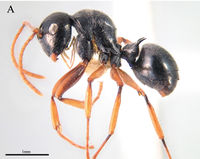Polyrhachis luteipes
| Polyrhachis luteipes | |
|---|---|

| |
| Scientific classification | |
| Kingdom: | Animalia |
| Phylum: | Arthropoda |
| Class: | Insecta |
| Order: | Hymenoptera |
| Family: | Formicidae |
| Subfamily: | Formicinae |
| Tribe: | Camponotini |
| Genus: | Polyrhachis |
| Subgenus: | Myrma |
| Species group: | revoili |
| Species: | P. luteipes |
| Binomial name | |
| Polyrhachis luteipes Rigato, 2016 | |
The type label states "mango" and this is the only biological detail known about this species.
Identification
Rigato (2016) - A small, thickset species in the revoili-group, with a lobed clypeal margin, minute pronotal teeth, a virtually unarmed propodeum, shining integument and testaceous legs.
Polyrhachis luteipes shows a variable development of propodeal ridges, as well as Polyrhachis dubia and, maybe, Polyrhachis longiseta. Polyrhachis luteipes is similar to Polyrhachis khepra, which is slightly larger, lacks an evident promesonotal suture, is more hairy, has a more sculptured head and darker appendages.
Keys including this Species
Distribution
Distribution based on Regional Taxon Lists
Afrotropical Region: Cameroun (type locality).
Distribution based on AntMaps
Distribution based on AntWeb specimens
Check data from AntWeb
Countries Occupied
| Number of countries occupied by this species based on AntWiki Regional Taxon Lists. In general, fewer countries occupied indicates a narrower range, while more countries indicates a more widespread species. |

|
Estimated Abundance
| Relative abundance based on number of AntMaps records per species (this species within the purple bar). Fewer records (to the left) indicates a less abundant/encountered species while more records (to the right) indicates more abundant/encountered species. |

|
Biology
Castes
Nomenclature
The following information is derived from Barry Bolton's Online Catalogue of the Ants of the World.
- luteipes. Polyrhachis luteipes Rigato, 2016: 30, figs. 9a-c (w.) CAMEROUN.
Unless otherwise noted the text for the remainder of this section is reported from the publication that includes the original description.
Description
Worker
Holotype. HL 1.09, HW 0.90, CI 83, SL 1.30, SI 144, FW 0.34, FI 38, PW 0.68, WL 1.40, HTL 1.16.
Clypeus ecarinate and with its anterior margin bearing a distinct protruding rectangular lobe, whose lateral corners are right-angled. Head in full face view oval, wider behind than in front, posteriorly widely convex. Eyes moderately large and convex. Mesosoma evenly convex in profile and immarginate. Pronotal humeri armed with two minute, diverging teeth. Propodeal dorsum with two faint ridges at its posterior corners. Propodeal dorsum and declivity confluent and forming a blunt obtuse angle in profile. Promesonotal suture clearly visible, metanotal suture faint. Petiole with a dorsal pair of moderately long and diverging spines and a pair of lateral sharp teeth; the space between dorsal spines straight. First gastral tergite anteriorly concave.
Mandibles at most superficially shagreened/striolate with sparse piligerous pits. The whole body mostly superficially reticulate, shining.
Standing hairs thin and pale, moderately abundant on body and appendages, relatively long especially on the head; longest hairs on scapes about four times as long as scape diameter at midlength. Longest standing hairs on tibiae about as long as maximum tibial width. Pubescence moderately long and sparse on the head, longer and fairly dense on the mesosoma, short and fairly sparse on the gaster.
Body and coxae black, mandibles, antennae and legs mostly testaceous; forefemurs mostly brown.
Paratypes (n=2). HL 1.22, HW 0.98–1.00, CI 80–82, SL 1.47–1.49, SI 147–152, FW 0.40–0.41, FI 41, PW 0.85, WL 1.57–1.59, HTL 1.32–1.36.
They mostly differ from the holotype by their completely unarmed propodeum, without any trace of teeth or ridges. Moreover, scape and first funicular joint mostly brown.
Type Material
Holotype. CAMEROUN: Mbalmayo, xi.1993 (N. Stork) (The Natural History Museum, specimen tagged: “F.93.6/1”). Paratypes. CAMEROUN: Minko Meyos, 15 S of Yaoundé, iii.1997, mango (J. L. Mercier) (2 w, BMNH).
References
References based on Global Ant Biodiversity Informatics
- Rigato F. 2016. The ant genus Polyrhachis F. Smith in sub-Saharan Africa, with descriptions of ten new species. (Hymenoptera: Formicidae). Zootaxa 4088: 1-50.

